
Regardless of your career field, you have an opportunity to excel in your area through a doctorate-level program. It is your path if you are interested in carrying out life-changing research or teaching. A doctoral degree also adds value to your CV and opens up many high-paying job positions.
However, it’ll take a while before you get to that high-paying and respectable position. It is a long-term commitment that pays little in the process and requires determination to continue research no matter what. Ph.D. programs are expensive, and while most of them are funded by means other than your own pocket, the latter option is also possible. Therefore, you have to clearly understand that you are positive about spending the next 4–8 years living on a salary that is hardly on par with the average living wage.
- How Much Does Education before Ph.D. Cost?
- How Much Does a Ph.D. Cost?
- Fully-Funded Ph.D. Programs
- Ph.D. Funding Options
- Ph.D. and Future Career
- Salaries for Doctoral Graduates
- The Final Thoughts
How Much Does Education before Ph.D. Cost?
Before we get to a Ph.D. cost and its funding options in detail, we have to note that a Ph.D. or a professional doctoral degree isn’t something you can apply for and get just because you want to. You can’t enter grad school before you’ve completed earlier stages of your education (which are not free of charge in the US as well). Before you get to a Ph.D., you have to complete at least one of the two first stages—a bachelor’s degree or/and a master’s degree.
Undergraduate Studies
University level first stage: Associate Degree (Associate of Arts (AA), Associate of Science (AS), Associate of Applied Science (AAS)), Bachelor’s Degree (Bachelor of Arts (BA), Bachelor of Science (BS), Bachelor of Applied Arts (BAA), Bachelor of Fine Arts (BFA)), Advanced Certificate, First Professional Degree
Graduate Studies
University level second stage: Master’s Degree (Master’s Degree in Business Administration (MBA), Master’s Degree in Education (M.Ed.), Master’s Degree in Accounting (MAcc), Master’s Degree in Public Health (MPH), Master’s Degree in Engineering (M.Eng.)), Post-Master’s Degree/Certificate, Diploma/Certificate, Degree of Education Specialist
University level third stage: Research Doctorate (Ph.D.), Professional doctoral degrees
| Profession | Professional Doctorate Degrees in the US |
|---|---|
| Deigner/Artist | Doctor of Arts (D.A./D. Arts) Doctor of Design (D.Des.) Doctor of Fine Arts (D.F.A.) |
| Advanced Practice Registered Nurse | Doctor of Nursing Practice or Doctor of Nurse Anesthesia Practice (DNP or DNAP) |
| Allopathic Physician | Medicinae Doctor and Doctor of Medicine (M.D.) |
| Audiologist | Doctor of Audiology (Au.D.) |
| Chiropractor | Doctor of Chiropractic (D.C.) |
| College Teaching | Doctor of Arts (D.Arts/D.A.) |
| Dentist | Doctor of Dental Surgery (D.D.S) Doctor of Dental Medicine (D.M.D.) |
| Government | Doctor of Public Administration (D.P.A.) |
| Health Science | Doctor of Health Science (D.H.Sc.) |
| Law and Policy | Doctor of Law and Policy (L.P.D.) |
| Lawyer | Juris Doctor or Doctor of Law Doctor of Jurisprudence (J.D.) |
| Management | Doctor of Management in Organizational Leadership (DM) Doctor of Management (D.Mgt.) Doctor of Management in Organizational Leadership/Information Systems Technology (DM/IST) |
| Minister/Clergy | Doctor of Ministry (D.Min.) Doctor of Practical Theology (D.P.T. or D.Th.P.) Doctor of Biblical Studies (D.B.S) Doctor of Hebrew Letters (D.H.L.) |
| Musician | Doctor of Music (D.M.) Doctor of Musical/Music Arts (D.M.A./A.Mus.D./D.Mus.A.) Doctor of Music Education (D.M.E.) Doctor of Church Music (D.C.M.) |
| Occupational Therapy | Doctor of Occupational Therapy (O.T.D.) |
| Optometrist | Doctor of Optometry (O.D.) |
| Osteopathic Physician | Doctor of Osteopathic Medicine (D.O.) |
| Pharmacist | Doctor of Pharmacy (PharmD), (PD), (DrPh), and (DPh) |
| Physical Therapy | Doctor of Physical Therapy (D.P.T) |
| Physician Assistant | Doctor of Science Physician Assistant (DScPA) |
| Podiatrist | Doctor of Podiatric Medicine (D.P.M.) |
| Psychologist | Doctor of Psychology (Psy.D.) |
| Public Health | Doctor of Public Health (Dr.PH.) |
| Social Work | Doctor of Social Work (D.S.W.) |
| Veterinarian | Doctor of Veterinary Medicine (D.V.M.) and Veterinariae Medicinae Doctoris (V.M.D.) |
Source: k12academics
Average Cost of College in the US
Now, let’s take a look at how much you pay before you even start your Ph.D. Here is the information about the average cost of tuition, additional expenses, and overall cost of attendance per year in colleges and universities (according to Eduсation Data Initiative):
More expensiveMore expensiveMore expensiveMore expensive
Public Institutions |
Cost of Tuition |
Additional Expenses |
Cost of Attendance |
| 4-Year Nonprofit | 💲 9, 349 | 💲 16, 138 | 💲 25, 487 |
| 4-Year For-profit | 💲 27, 023 | 💲 16, 138 | 💲 43, 161 |
| 2-Year Nonprofit | 💲 3, 377 | 💲 12, 371 | 💲 15, 784 |
Public Institutions |
Cost of Tuition |
Additional Expenses |
Cost of Attendance |
| 4-Year Nonprofit | 💲 35, 807 | 💲 17, 410 | 💲 53, 217 |
| 4-Year For-profit | 💲 14, 957 | 💲 20, 168 | 💲 35, 125 |
| 2-Year Nonprofit | 💲 16, 898 | 💲 17, 121 | 💲 34, 019 |
| 2-Year For-profit | 💲 15, 333 | 💲 17, 046 | 💲 32, 379 |
So we can see that
- The cost of one academic year for an average in-state student attending a public 4-year institution is $25,487.
- In-state average tuition costs on average $9,349.
- Out-of-state tuition costs on average $27,023.
- Private education will cost a student of a 4-year college $53,217 per academic year, including tuition ($35,807) and expenses ($17,410).
Many students have to take loans to be able to afford college. Therefore, if we add loan interest and loss of income, a bachelor’s degree can cost as much as $400,000 to a student. However, this isn’t the maximum cost yet. Several universities are known for having the most expensive college tuition, which means the expenses can be even higher at those institutions.
Average Cost of an Associate Degree
Associate of Arts (AA), Associate of Science (AS), Associate of Applied Science (AAS), Associate of Nursing (AN)/Associate Degree Nurse/Nursing (ADN), Associate of Engineering (AE/AEng), etc.

In 2020-2021, the average cost of an associate degree ranged around $11,557 per year from a public institution and $25,667 per year from a private institution, according to NCES.
An associate degree is a 2-year undergraduate academic program that covers the fundamental knowledge of a subject and allows getting a profession twice as fast and at a lower cost than a 4-year college.
Average Cost of a Bachelor’s Degree
Bachelor of Arts (BA), Bachelor of Science (BS), Bachelor of Applied Arts (BAA), Bachelor of Fine Arts (BFA), Bachelor of Technology (B.Tech.), Bachelor of Engineering (BE/BEng), etc.

In 2020-2021, the average cost of a bachelor’s degree ranged around $21,337 per year from a public institution and $46,313 per year from a private institution, according to NCES.
The bachelor’s degree is a four-year academic program where students learn about a broad range of subjects and choose their major. It may or may not be preceded by an associate degree.
Average Cost of a Master’s Degree
Master’s Degree in Business Administration (MBA), Master’s Degree in Education (M.Ed.), Master’s Degree in Accounting (MAcc), Master’s Degree in Public Health (MPH), Master’s Degree in Engineering (M.Eng.), etc.

The cost of a master’s degree ranges broadly from $30,000 to $120,000 on average, depending on the program, field, school, additional fees, and other factors. STEM programs are more expensive than programs in education, for instance.
A master’s degree gives an opportunity to get deeper into a specific field of expertise. Master’s degree programs require a prior bachelor’s degree (either from the same school or at least in the same subject field) and a follow-up thesis or internship to graduate.
According to MBA TODAY, this is the list of the most expensive MBA programs in 2021: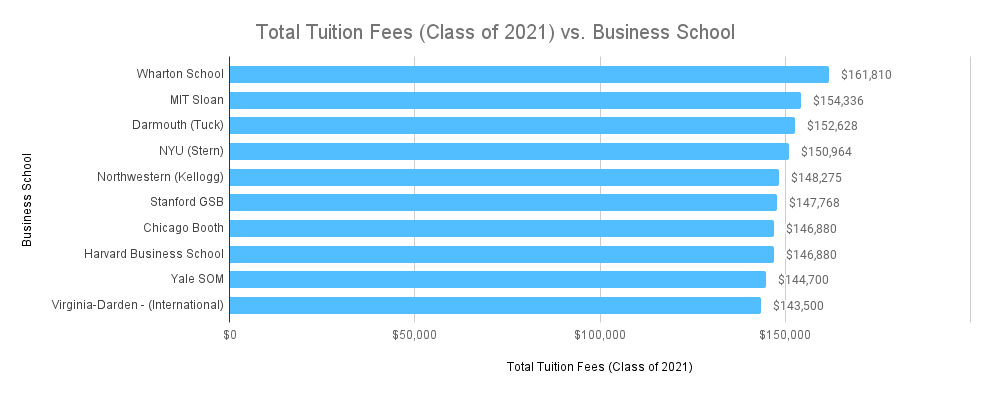
How Much Does a Ph.D. Cost?

The cost of a Ph.D. in the US ranges from $28,000 to $40,000 per year
![]()
With this being said, we should explain that when it comes to Ph.D. costs and funding, you can have a range of options from full funding plus a stipend to no funding and no stipend
Depending on the school, the type of research, and field of study, the department resources as well as some other things, the amount of the tuition waiver, the stipend, and any other allowances will vary greatly.
Some Ph.D.s are funded as a combination of teaching assistantships and research assistantships, which means that some of the funding comes from the university department, and some come from the individual faculty member grant funding. In this case, a Ph.D. student doesn’t pay anything and usually gets a stipend (=salary).
Other universities offer doctorate-level degree programs that are either not funded at all or not fully funded. In this case, to pay for a Ph.D., a student has to take loans or work full-time and do a Ph.D. simultaneously, which is quite a challenge, as a Ph.D. is no less than a full-time job.
What Does Ph.D. Cost Depend On?
Choice of School
The more prestigious college with a long-standing reputation and location offers the most expensive Ph.D. programs. Private programs also usually cost more than public ones.
Here is an example of average graduate tuition for Ph.D. candidates at Columbia University from 2009 to 2021 (according to Statista):

Field of Study
STEM and medical programs are usually more expensive than programs in social sciences.
Type of Ph.D.
There is a difference between a Ph.D. and a professional doctorate degree, though both will give you a doctorate title. The former is an academic and research-focused degree; the latter is a research degree that is focused on the application of research findings into practice. Doctorate programs differ in terms of research complexity. For instance, if you are considering a doctorate program in Psychology, a Ph.D. is heavier on research than Psy.D., which focuses more on clinical training. A Ph.D. also gives you an advantage in the competition for a teaching position.
Location of School
If you live in the same state where the college or university of your choice is located, your doctorate program will cost you less. In-state and out-of-state students pay differently for the same studies. For instance, in the Leeds Ph.D. Program from the Leeds School of Business, “The 2020-2021 stipend is $30,000 for the academic year. Ph.D. students funded by Leeds School of Business are required to work 20 hours per week as a research or a teaching assistant. The tuition waiver is equal to approximately $16,866 for a Colorado resident and $35,100 for a non-Colorado resident.”
Amount of Student Loans
If you are unlucky and your program isn’t fully funded, you may consider taking a loan in the amount that’ll cover your program and additional costs. In this case, the overall cost of your Ph.D. will be even higher as interest should be added to the initial loan amount.
Average Ph.D. Cost
A doctorate degree takes, on average, from 4 to 8 years in the US. The average cost of a Ph.D. is $114,300 (according to Eduсation Data Initiative).
- The average cost of a doctorate degree from a public university is $92,200.
- The average cost of a doctorate degree from a private university is $127,100.
Doctor of Philosophy (Ph.D.)
The average cost of a Ph.D. is $98,800.
A Ph.D. is one of the longest doctorate programs that takes up to 8 years to complete. While some universities offer full funding, most Ph.D. students offset the cost of their degree with teaching assistantships.
Doctor of Education
The average cost of a Doctorate in Education is $111,900.
Doctorate programs in Education are funded on a smaller scale than the ones in STEM subjects. Therefore, students have to offset the cost of the degree with their own funds. They usually choose between a Doctorate in Education and a Ph.D. in Education. The former is more focused on professional practice and is shorter, while a Ph.D. in Education focuses on research and teaching and takes longer to complete.
Doctor of Psychology
The average cost of a Doctorate of Psychology is $132,200.
The same applies to doctorate programs in Psychology: less generous funding, more time to complete a Ph.D. in Psychology (focused on researching and teaching), and less time to complete a Psy.D. in Psychology (focused on direct clinical practice).
How Much Does an Online PhD Cost?
Nowadays, online Ph.D. programs are also broadly available. The average cost of an online Ph.D. program can range from $4,000 to $20,000+. Over 400 colleges and universities offer online doctorate programs. According to the Research website, here are the five most affordable online schools for doctorate programs:
🏛️Institution |
💲Tuition |
💲Fees |
💲Total |
🎓Programs |
| Shiloh University | 💲 3, 420 | 💲 0 | 💲 3, 420 | Theology and Religious Vocations |
| Columbia Southern University | 💲 3, 900 | 💲 135 | 💲 4, 035 | Business, Management, Marketing, and Related Support Services |
| Abraham Lincoln University | 💲 4, 800 | 💲 200 | 💲 5, 000 | Legal Professions and Studies Business,Management, Marketing, and Related Support Services |
| Taft University System | 💲 5, 400 | 💲 190 | 💲 5, 590 | Education, Legal Professions and Studies |
| American College of Education | 💲 5, 640 | 💲 960 | 💲 6, 600 | Education |
Fully-Funded Ph.D. Programs
While some universities claim that they have fully-funded Ph.D. programs, in reality, you need to check the terms and conditions of each in detail. In fact, fully-funded Ph.D. programs are a great privilege, such positions are few, and the competition is insane. Fully-funded Ph.D. programs let a student focus on the research entirely without the need to spend half of the time teaching or assisting others or meeting any other conditions. However, such cases are rare. Here are some of the examples where a Ph.D. program is claimed to be fully funded:
- Columbia University provides full funding to its Ph.D. students doing research in the field of medicine, sciences, public administration and policy.
- Boston College’s Department of Psychology offers a fully-funded, research-oriented doctoral program (to cover 4 or 5 years of research).
- Duke University offers a Ph.D. program in History with multi-year funding packages.
- The Joint Program in Social Work and Social Science at the University of Michigan is also covered by a funding package that includes tuition, stipends, and health care.
A full list of such options can be checked on the Profellow website, where they give comprehensive lists of fully-funded Ph.D. scholarships in every field.
Ph.D. Funding Options
Yet, most of the time, students don’t get full funding, or the funding is conditional and should be compensated by doing certain teaching and research assistant-level work on campus. In other cases, students have to cover all Ph.D. expenses themselves.
Ph.D. Stipend (Salary)
The amount of stipend depends on many factors:
- The amount of a grant that an advisor or a professor has received
- The number of workers needed in the research
- The university rules
- The department’s overall funding potential
- The minimum/average living wage for the county in which the university resides
- The level of program competition
While getting a stipend/salary is better than not getting it at all, its amount is usually not high. In some cases, it’s not enough to cover average living costs.
You can check the information about Ph.D. student stipends and salaries on Phdstipends in many disciplines at universities all over the US and compare the real facts with your expectations. For instance, if you are considering applying for a Ph.D. program at Auburn University, you may find this information useful:
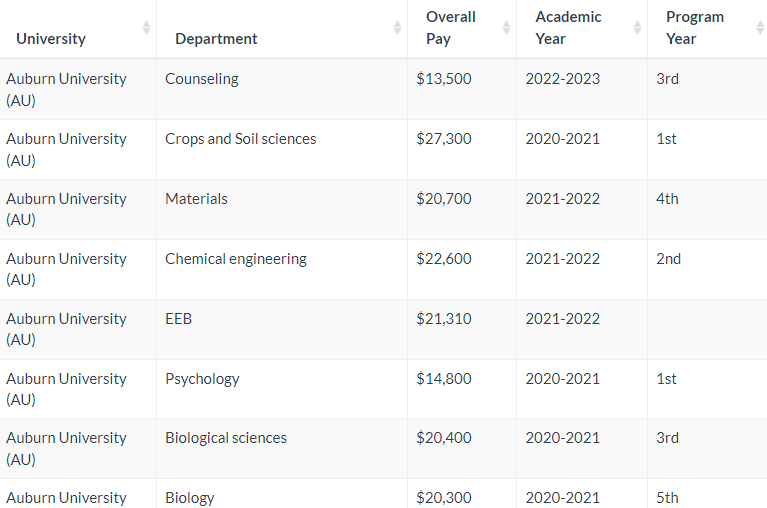
Source: Phdstipends
The Association of American Medical Colleges (AAMC) reported that residents and fellows receive, on average, a mean unweighted stipend of $59,279 for each program year. We retrieved the data as of July 1, 2021, from the AAMC Survey of Resident/Fellow Stipends and Benefits Report:
🏛️Year of Training |
💲Mean Unweighted Stipend |
| Program Year 1 | 💲 59, 279 |
| Program Year 2 | 💲 61, 344 |
| Program Year 3 | 💲 63, 890 |
| Program Year 4 | 💲 67, 047 |
| Program Year 5 | 💲 69, 894 |
| Program Year 6 | 💲 72, 657 |
| Program Year 7 | 💲 75, 728 |
| Program Year 8 | 💲 75, 728 |
Also, according to the recent research carried out by two Ph.D. biology students, Ph.D. student salaries in the biological sciences are way below the basic cost of living. We recommend checking the research, as it’s regularly updated, mostly focused on biology science programs, and can serve as a very good illustration of the overall grad student salary situation: a very small percentage of institutions and departments seem to be able to offer salaries above the cost of living threshold.
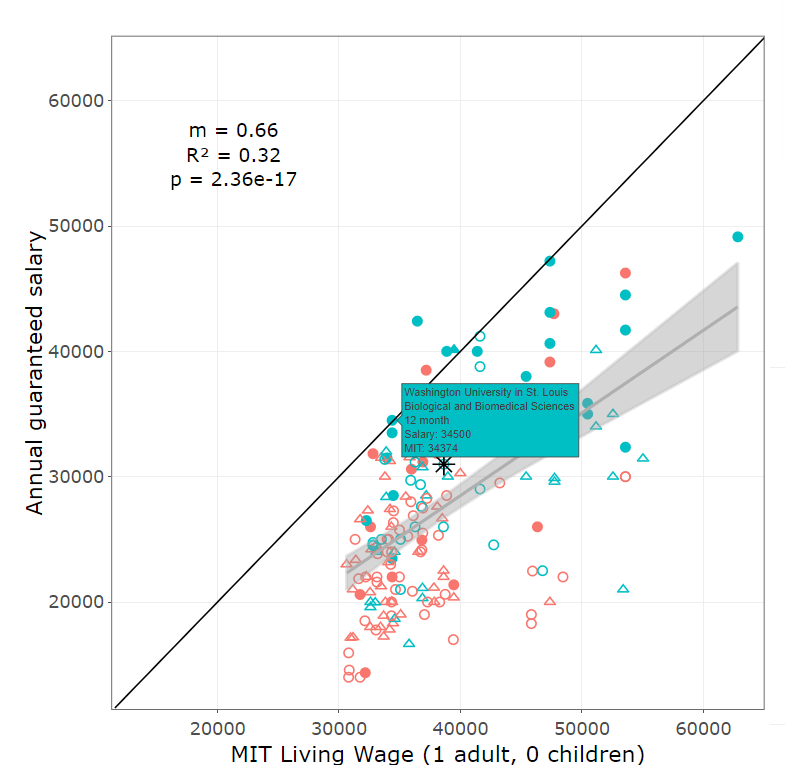
Source: https://rhettrautsaw.app/shiny/BiologyPhDStipends/
How to Fund a Ph.D.?
According to the Survey of Earned Doctorates (SED) (Doctorate Recipients from U.S. Universities: 2020—the most recent report we’ve found; the next release is expected in November 2022), major sources of Ph.D. funding are
- Research assistantships
- Teaching assistantships
- Fellowships
- Scholarships
- Dissertation grants
- Student’s own resources (loans, personal savings, personal earnings; spouse, partner, or family assistance)
- Other resources (employer reimbursement, foreign support)
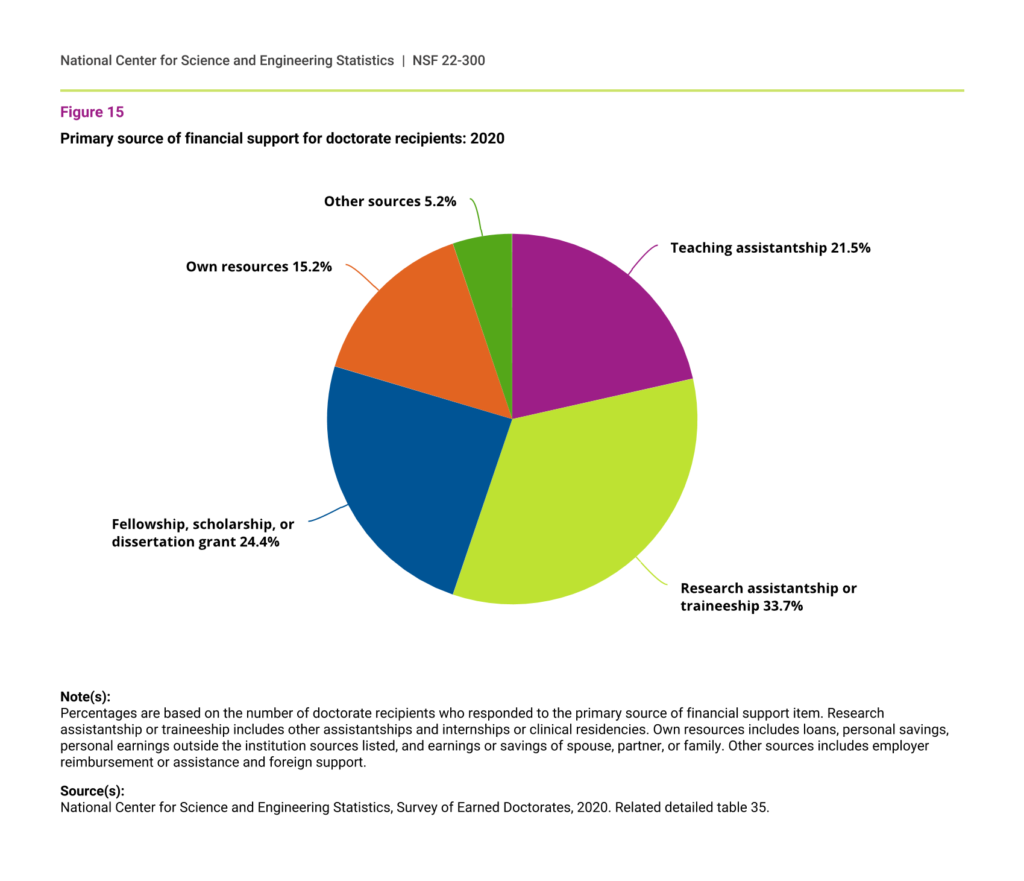
Source: NCSES
So, if your Ph.D. program is not fully-funded, here is what you can consider to cover the program parts that are not funded (or an entire program if that’s the case).
Make a Thorough Plan
First of all, you have to clearly understand why you want to pursue this path. Since an average doctorate program lasts for 8 years, which is a very long time, you have to be passionate about your research and have a clear vision of your goals and milestones. This is especially relevant for programs that offer insufficient funding. Do not overestimate your financial potential.
Check Your Ph.D. Program Conditions
If you plan to do research in STEM subjects or medicine, seek the programs that are funded by the National Research Council. There may be options to get financial help either individually or via scholarships. They also fund group and department research projects.
Nongovernmental Research Grants
Apart from governmental, federal, and state grants, there are many other funding alternatives that can be sought out to support research on a particular topic. We encourage you to learn about them all in your field of study. Check Educationusa for more information.
Apply for Assistantships
As an assistant, you will be expected to officially work up to 20 hours a week; however, in reality, you may be working more. There are three major assistantship paths:
- Research assistants help faculty in their research.
- Teaching assistants either assist faculty in teaching or teach classes themselves.
- Graduate assistants usually combine the functions of the ones mentioned above.
Assistantships are usually paid in the form of a salary (stipend) we’ve discussed earlier. Keep in mind, however, that not all departments have resources for assistants, and you will most likely have to compete with other Ph.D. students to get the position.
Apply for Fellowships
Ph.D. fellowships in the US help you get your tuition waived, get a stipend in the amount sufficient enough to cover your living expenses, and allow focusing on research without the need to fulfill any assistantship obligations. To become a fellow, you may need to apply separately to other organizations, as fellowships are frequently offered outside universities. The drawback is that Ph.D. fellowships are highly competitive and, as a rule, don’t cover the full duration of the studies.
Consider Getting Funds from Your Current Job
If you are a Ph.D. student and a current employee at a company, you can also inquire about their employee funding opportunities. Some businesses have financial assistance programs for workers who are getting a Ph.D.
Consider Getting a Loan
While this is an unfavorable option, you shouldn’t wave it aside at once. If your research is important and, at some point, you run out of all funding options, you can take a loan as a last resort.
Ph.D. and Future Career
Here is the number of doctoral degrees earned in the United States in 2019/2020 by field of research (according to Stataista):

Source: Statista
So where did all those people go? Where can you go after getting your Ph.D.? There has been a clear trend recently for doctorate graduates to go into non-academic employment; however, many stay in the academic field as well. Here are the options that post-doc graduates can choose to pursue:
- A post-doc position at the institution where you got a Ph.D.
- A faculty position at the institution where you got a Ph.D. or at another university
- An adjunct position at your university (non-tenure-track position)
- Teach at an undergraduate institution
- Join a company in your field of specialization
- Become a consultant to policymakers and help put research into practice
- Become a business consultant
- Become an entrepreneur and start your own business
- Work for government and public services
- A career in science communication and science journalism
- Take any path you like
Salaries for Doctoral Graduates
It is true that the job market for new Ph.D. recipients is better or worse in some fields of study than in others every year. While degree and specialization play a crucial role, the industry and the position also influence the amount of the annual pay. According to the Survey of Earned Doctorates (SED), in 2020, in every field, the “median expected salaries for doctorate recipients committing to jobs in industry or business were higher than those in postdocs and academe.”

The median salaries for postdocs in almost every field ranged from $50,000 to $55,000 in 2020.
- Postdocs in mathematics and computer sciences were an exception, as their median salary was $61,000.
- The highest median academic salaries—$85,000 and $90,000—were reported in engineering and other non-science and engineering fields, such as industry or business.
- The highest median salaries in industry or business positions—$144,000—were reported in the fields of mathematics and computer sciences.
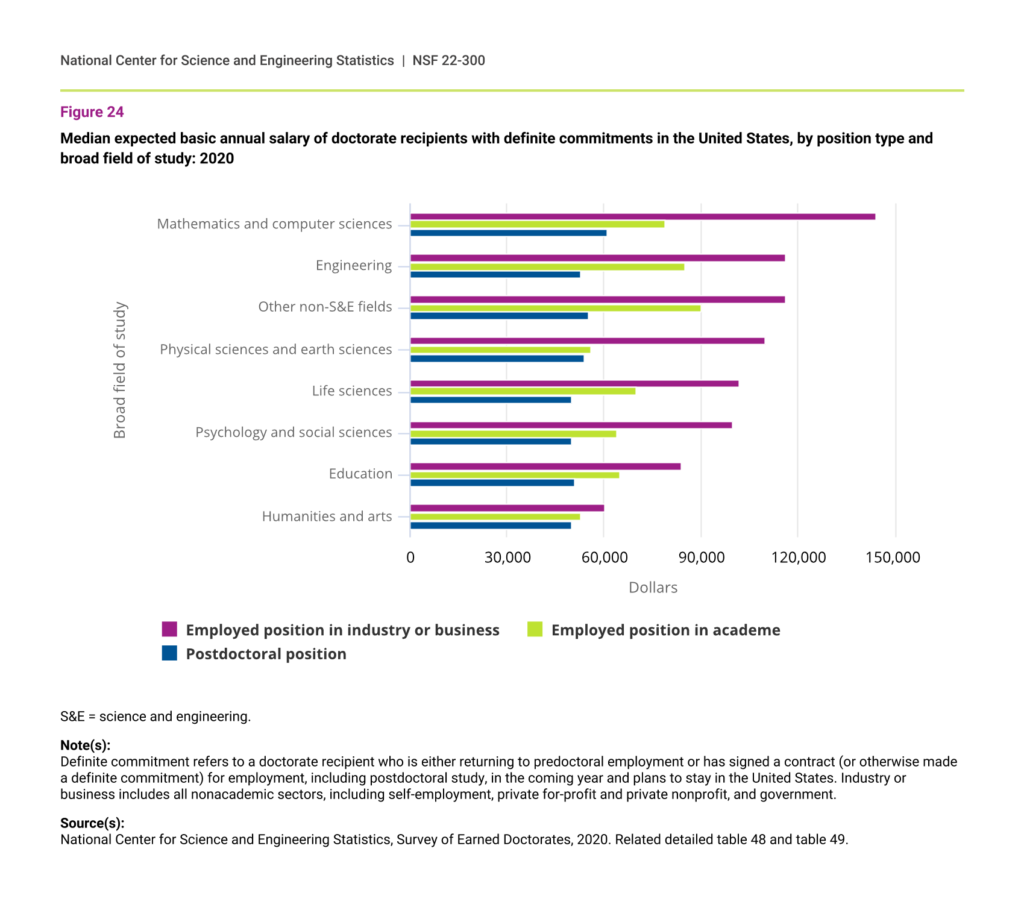
Source: NCSES
Yet, as we’ve already mentioned, getting a Ph.D. comes with financial strings attached. Here is another chart that shows the correlation between the expected salary in a chosen field and the education-related debt. Apparently, doctorate recipients in the science and engineering fields have the lowest median cumulative debt and the highest median expected annual salaries; in business management and administration, graduates have a higher debt but also the highest expected salary of all. As opposed to these, doctorate recipients in the fields of psychology and other non-science and engineering fields are reported to have the highest median cumulative debt and the lowest median expected annual salaries.
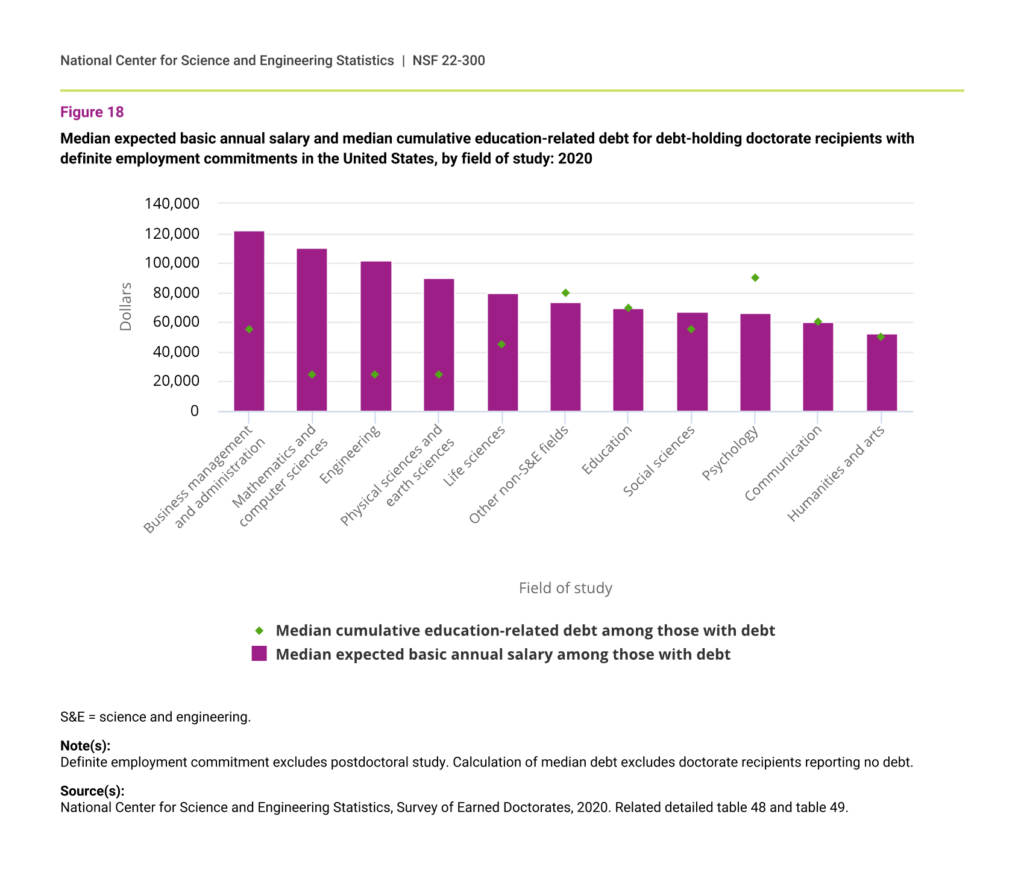
Source: NCSES
The Final Thoughts
As you can see, the topic of Ph.D. cost is quite an extensive one. There are many things that you should be aware of before deciding to pursue the doctorate path, as apart from being a respectable one, it also requires a huge investment.
Remember that your program may not be fully funded, so you’ll have to cover the rest of its cost by other means. Besides, the years you’ll spend doing your doctorate can be spent getting valuable practical experience and gaining a promotion, which is not what Ph.D. programs focus on.
Yet, if research is what you are solely interested in and passionate about and the academic field is where you excel, getting a doctorate degree is well worth the cost and a perfect choice for you.
References:
- 20 most affordable online doctorate programs in 2022. Research.com. (2022, May 30). Retrieved June 27, 2022, from https://research.com/degrees/most-affordable-online-doctorate-programs
- AAMC survey of resident/fellow stipends and benefits. AAMC. (n.d.). Retrieved June 27, 2022, from https://www.aamc.org/data-reports/students-residents/report/aamc-survey-resident/fellow-stipends-and-benefits
- Average graduate tuition for Phd students at Columbia University 2021. Statista. (2021, December 13). Retrieved June 27, 2022, from https://www.statista.com/statistics/939141/ivy-league-average-graduate-tuition-phd-students-columbia-university/
- Biology PhD Stipends 2022. Rhett Rautsaw’s droplet. (2022). Retrieved June 27, 2022, from https://rhettrautsaw.app/shiny/BiologyPhDStipends/
- Digest of Education Statistics, 2021. National Center for Education Statistics (NCES). (2021). Retrieved June 27, 2022, from https://nces.ed.gov/programs/digest/d21/tables/dt21_330.10.asp
- Doctorate recipients from U.S. universities. NSF. (2020). Retrieved June 27, 2022, from https://ncses.nsf.gov/pubs/nsf22300/
- Hanson, M. (2022, February 3). Average cost of a doctorate degree [2022]: Ph.d., psy.D. more. Education Data Initiative. Retrieved June 27, 2022, from https://educationdata.org/average-cost-of-a-doctorate-degree
- MBA tuition fees (2020/2021): Calculating the cost of your studies. MBA Today. (2021). Retrieved June 27, 2022, from https://www.mba.today/guide/fees
- PhD Stipend Survey Results. Results – phd stipends. (2021). Retrieved June 27, 2022, from https://www.phdstipends.com/results




